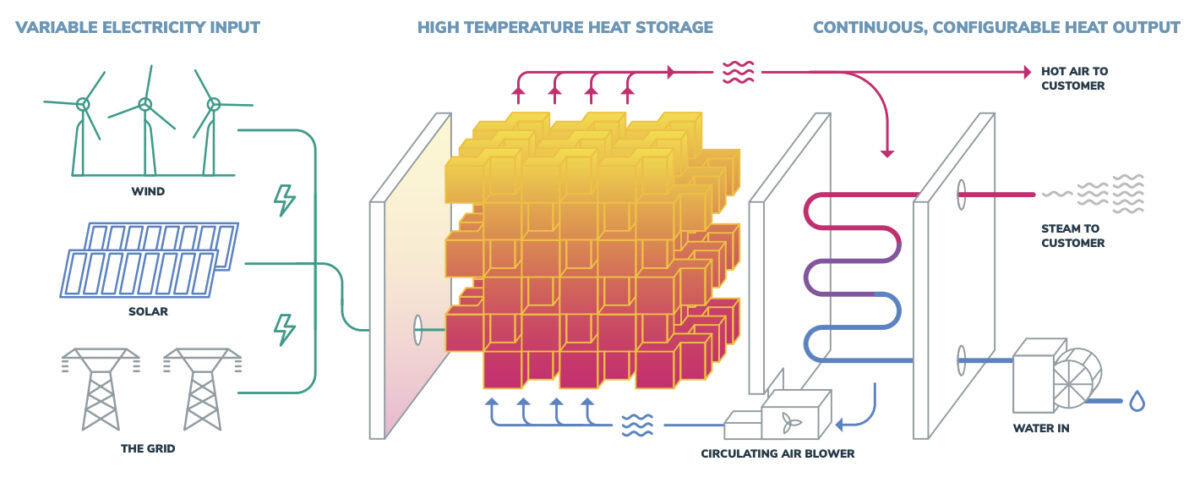Firebrick systems powered by renewable energy could be used for up to 90% of industrial process heat applications, the Stanford study says. Meeting that demand in the U.S. would require firebrick system capacity of 2.6 TWh, with a peak discharge rate of 170 GW.
This seems like a stupid idea at first but it’s actually amazing. They mix high resistance metals into the bricks so the bricks can conduct electricity and heat up while doing that. And then they blow air through the holes on the bricks to extract the heat whem needed. It leaks about 3% of the stored energy per day which is absolutely nothing considering it’s cost
I’m gonna drop these papers here. First one is more of a brief intro and the second one discusses practicality and logistics of such systems
https://inldigitallibrary.inl.gov/sites/sti/sti/Sort_8882.pdf
https://www.sciencedirect.com/science/article/abs/pii/S0306261919305082
I would think molten metal would be more effective for this, molten sodium or lead or something? Maybe some kind of Tin/Lead eutectic like old solder?
Firebricks just seem inefficient somehow, particularly since the heat isn’t going to be uniform, while molten metals or salts can circulate and convect the heat more efficiently than… air.
The main advantage of using what is basically dirt is that it’s dirt cheap. You need a metric fuckton of this stuff so the cheaper the material, the better. Also, molten metal is difficult to handle.
Fine, but given … everything, it seems like you could do some smaller system with channels in the bricks for conduction, it’s the hot air that bothers me, that’s not great to try to use for conducting energy everywhere, you get turbulent effects.
How else would you heat up a huge pile of bricks? This is for industrial applications or grid scale heating systems. They basically all use hot air.
They use hot air warmed by gas burners.
Since we’re using electricity here, and this was mentioned in the study linked elsewhere, they used ceramic heaters.
Their previous study also goes into efficiency and cost.
One of the main advantages of firebricks is their low cost.Ok, they’re claiming 98% rt efficiency.
I don’t think we have 98% rt efficiency in anything, ever. That’s miraculous. Batteries are around 92% at best? Pumped hydro is 85% or so.
That even sounds high for raw carnot efficiency.
I mean, if so, wow, that’s awesome, and I don’t really doubt their 1% daily decay, that seems attainable.
But 98% rt? I’m still skeptical.
It’s heat though. They’re turning electricity into heat then moving that heat to where it’s needed, when it’s needed. Making heat from electricity is nearly 100% efficient, and pumping losses for moving fluids are going to be tiny compared to the the amount of heat they can move. They quote the heat loss in storage seperately as 1% per day. It seems reasonable.
I can buy all of it, near perfect heating, but 2% for their forced air circulation combined with turbine and generation losses? Seems too good to be true.
Chatgpt (because we’re all lazy) :
Total Thermal to Electrical Efficiency
The overall thermal-to-electrical efficiency of a power plant, often referred to as plant efficiency, is the product of the steam turbine efficiency and the generator efficiency. Typical overall efficiencies for fossil-fuel-based steam turbine power plants (e.g., coal, natural gas) range from 33% to 40%.
In more advanced configurations like combined cycle power plants, which recover waste heat from the steam turbine exhaust to generate additional electricity, efficiencies can reach 50% to 60%.
Calculation Example:
If the steam turbine has an efficiency of 40%, and the generator has an efficiency of 98%, the total thermal-to-electrical efficiency would be:
\text{Total Efficiency} = 0.40 \times 0.98 = 0.392 \text{ or } 39.2%
So, for every 100 units of thermal energy input, 39.2 units are converted into electrical energy.
And that’s if you’re just heating the water before it hits the turbine, including the air circulation and basic entropy (there’s a limit to how much you can pull out via heat differential), it seems like it should go down from there.
They’re not converting it back into electricity, this is for industrial process heat. They have 100 units of electrical energy and 98 units go into whatever the industry needs to heat.
Lots of industries use ovens, kilns or furnaces. Mostly fueled by gas at the moment. Using electricity would be very expensive unless they can timeshift usage and get low spot prices. Since they need heat anyway, thermal storage is pretty cheap and efficient.
Oh, my bad. That makes perfect sense and I have no objections for purely thermal storage.
It said steam to customer, my brain filled that in with turbine.
I am not a material scientist, but I would wonder if molten metals would radiate too much heat to the environment causing an efficiency loss




